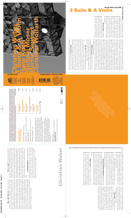|
What Christian Weber and Co. have achieved on 3 Suits And A Violin is a music that eschews formulaic approaches and instead temper their group sound in dense laminations of texture and sonic residue. This album was recorded over two days at the Radio Studio Zürich in 2002. The result is an arresting music which combines elements of group-improvised minimalism, electro-acoustic improvisation and avant-garde chamber music into a texturally rich exploration of detailed noise texture. Recent trends in contemporary music have embraced noise and varying degrees of instrumental tension and distress. We often refer to extended technique, a term for the scrape/scratch techniques which stemmed from 'avant-garde' music. With the use of deconstructive approaches in electro-acoustic music, where noise is a material which has been given much consideration – this is an area which has been explored extensively through any number of extensions, computer/electronic integration and willful assault. Christian Weber is an artist who has grown into what could be called a European tradition after avant-garde, in informed by improvising groups such as AMM, MEV, Art Ensemble of Chicago, FMP through to Voice Crack et al. Christian Weber is amongst a small group of artists who have taken the liberty that |
sound was given through those movements in improv and developed and extended this language with more formal/structural considerations. In that, Christian Weberís works incorporate choreography and repetition, adhering to strict conceptual and formal guidelines. Weber lays out principles of time, space and dynamic to the group, and these plans establish the systems that give these pieces very deliberate shape, and into these architectures he invites the improvisers who at their own accord interpret with a great degree of freedom and experimentation. Weber's process in this set owes a lot to the individual player characteristics and temperaments, having chosen to work with these players for their ability to interpret his conceptual approach with rigorous ear for detail. The way Michael Moser approaches his instrument is profoundly unique, he seems almost contentious to conventional modes for the instrument, and plays with a decisiveness and humor that puts spikes into the ambient flow. The cellist can quickly refract an idea that may start as a small harmonic shadow into full-blown arching tone projections. The effect of his instrument on the ensemble sound is like a |
discrete textural device, which intervenes through the rhythmic/tonal spectrum as a ghostly mimic, tracing the lines and folds.
Martin Siewert embodies an entire canon of conventions and divergences related to the guitar, that can run the gamut from steely conventional picking and slide atmospherics to warped avantist code scrambling via sundry effects and extended techniques. His approach to the instrument is highly exploratory. His astuteness for harmony guides 3 Suits And A Violin throughout, with a principle of suggested harmony that stems from a number of modulating effects, artfully placed transparent resonances and twilit plucked notes. A high-register saxophone intonation tailed by a lip-and-reed click, the bell of Hans Koch’s instrument clearly audible, his instrument appears in an extraordinarily tangible sonic dimension. Using bass clarinet, saxophone and electronics his appearance here is mercurial, placing pure-tone vector lines across the sub-surface, and punching mechanical lines with keys that spill percussive patterns into the fray. |
|||||||||||||
